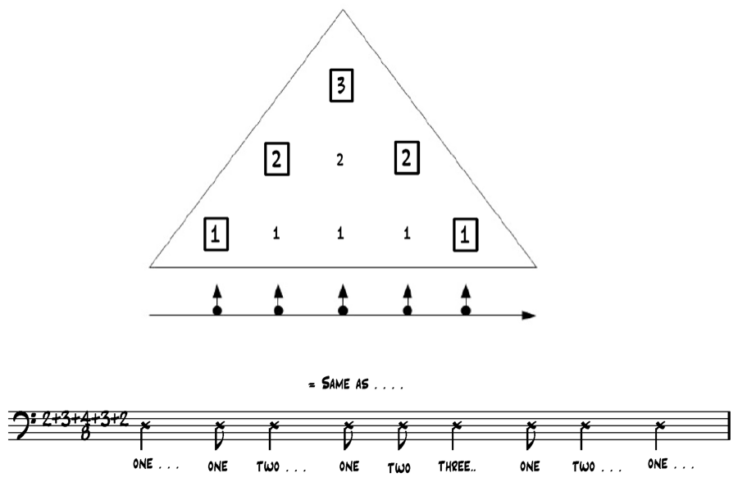Complex Time Signatures – Introduction to the Concept of Pyramid Rhythms
Recordings of Ken improvising with these rhythms can be found here:
‘Crooked Crooks Cracks’ by Ken Stubbs
video/score
‘Lonely Together’ by Ken Stubbs
video/transcription
‘Countdown’ by John Coltrane
video/transcription
The inspiration for the development of what I have termed, Pyramid Rhythms, came mainly from 2 different sources.
Pyramid Rhythms are really just complex time signatures IE: 7/4, 7,8, 23/8 etc. However using the triangular image of a pyramid as a visual learning method has given me a completely different approach to understanding and developing a feel(ing) for these types of rhythms.
So, the first source of inspiration came from seeing the Dave Holland Quartet performing at Ronnie Scott’s Club, in London, in 1990. The musicians performing with him were, Steve Coleman on alto sax, Kevin Eubanks on guitar and Marvin ‘Smitty’ Smith on drums and percussion.
What was particularly amazing about the way that they all improvised together, was the total freedom that they all shared, even though most of the tunes structures used complex time signatures. They seemed to be able to play anything, and yet were completely aware of the song form, the bars and beats, which ran like an invisible thread throughout each piece; and the groove was amazing.
It seemed to me that to have such rhythmic independence from, yet cohesion with, other musicians was one of the great challenges for an improvising musician. (Same for harmony too, and we can talk about that elsewhere.)
That same year I toured Canada and the USA with Loose Tubes, the British jazz ensemble. The band was fortunate to include, Thebe Lebere, a great South African percussionist. Thebe was one of the African musicians that emigrated to Europe to be free of the racial segregation that was being enforced in South Africa under the system of Apartheid. The London jazz scene, in particular, benefited from the arrival of musicians such as Thebe, Dudu Pukwana, Louis Moholo, Mongezi Feza, and many others.
Anyway, during this tour, Thebe showed me a counting game that he used to play as a child with other kids.
It went something like this:
Count out loud:
(1)
(1) (1,2) (1)
(1) (1,2) (1,2,3) (1,2) (1)
(1) (1,2) (1,2,3) (1,2,3,4) (1,2,3) (1,2) (1)
(1) (1,2) (1,2,3) (1,2,3,4) (1,2,3,4,5) (1,2,3,4) (1,2,3) (1,2) (1)
…..ad infinitum……
Can you see the pattern?
Basically, each time you start a new group of numbers (shown on each separate line) you go one ‘step’ higher, and you always come down the way you went up……symmetrically.
Also, the ‘rhythm’ that you should use to say the numbers goes like this:
Bold = quarter note (crotchet)
Normal = eigth note (quaver)
(1)
(1) (1,2) (1)
(1) (1,2) (1,2,3) (1,2) (1)
(1) (1,2) (1,2,3) (1,2,3,4) (1,2,3) (1,2) (1)
(1) (1,2) (1,2,3) (1,2,3,4) (1,2,3,4,5) (1,2,3,4) (1,2,3) (1,2) (1)
OK, now instead of saying it out loud, clap it instead.
And that is the game….go as high as you can….if you make a mistake, you are ‘out’… the last person left is the winner.
I noticed that if you wrote these out using the European method of bars and beats, each ‘line’ of numbers gave an unusual time signature.
Counting to 2 is in 7/8
Counting to 3 is in 7/4
Counting to 4 is in 23/8
As a result of this realisation I have used this system to develop the rhythmic independence that I mentioned earlier.
With students – It is fun to set them the task of playing or singing in 7/8 (or 23/8) …..then after the looks of fear and despair, show them the game, getting them to ‘loop’, counting up to 2.
Sometimes it helps to get them to visualise it as upward moving steps like this:

or 7/4:

The realisation of being able to feel these rhythms using this simple method, rather than getting in knots thinking about the bars and beats seems to have a profound effect on the confidence of the learner.
More importantly though, I have noticed that after students have learned some of these complex rhythms, their feel, groove, accuracy or whatever you prefer to call it is improved, especially when playing in 4/4 or 3/4 etc.
It also can be used to ‘cure’ the foot tapping problem.
By this I mean the need to always tap your foot to feel confident of the beat or tempo. This seems to me to alienate a musician from the unity of feel that they should be tuning into with other musicians; a feel that is not rigid like a metronome, but that can move and develop in an organic way. This can only happen if each musician has dropped their own metronomic foot tapping.
By the way, I do not mean, if you are moving with the music, as if you are dancing with it …..as long as you know that you are not using your foot as a stabiliser.
In fact, a good analogy, is a child needing stabilisers on a bicycle, until they learn how to balance on their own.
On the site you will find various exercises within the Lesson Plans that use these rhythms.
Start with this Course, which does not require you to play an instrument, then progress to the plans that incorporate scales, phrases etc.
The Dave Holland Quartet that I mentioned, recorded one album in 1990:





Comments